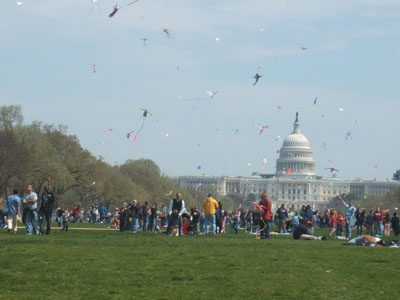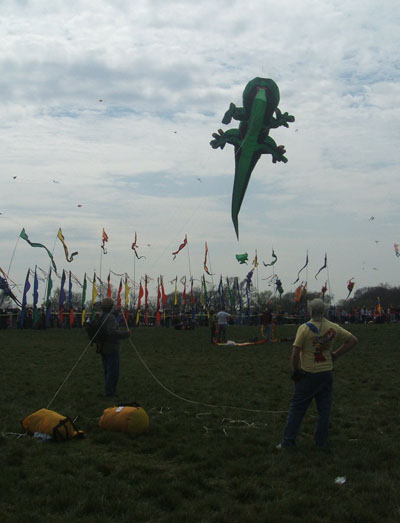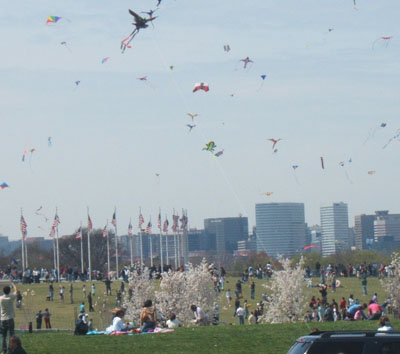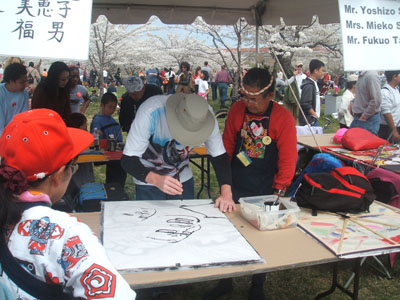
Mall Kite Festival fills skies with family fun
WASHINGTON, D.C.— As his rainbow kite caught a gust of wind and flew triumphantly along side the Washington Monument, eight-year-old Matthew Bills jumped with delight on the lawn of the National Mall.
“I finally got it to fly,” said Matthew, of Alexandria, Va. “Flying a kite is really fun.”
Just a few yards behind Matthew, tall multi-colored windsocks marked the 41st annual Smithsonian Kite Festival.
 |
Hundreds of people fly kites on the lawn of the National Mall in front of the Capitol Building during the Smithsonian Kite Festival (Photo by Elise Fender). |
The Smithsonian Kite Festival is the one day of the year when the sky above the National Mall is as colorful and diverse as the lawn below. Everything from triangular Spider-Man kites to patriotic kites to kites shaped like dragons dotted the air as their owners worked hard down below to keep them aloft.
“This is a nice spring day, great for flying a kite,” said Martin Bills, Matthew’s father, who brought his wife and son to Washington for the day at the end of March to join 10,000 others in celebrating the art of kites. “Its worth battling the crowds to come out to the Kite Festival, we come every year.”
The Smithsonian Kite Festival, sponsored by the Smithsonian Associates and National Air and Space Museum, is held annually in the spring in conjunction with the blooming of cherry trees and is one of the most popular events during Washington’s two-week long Cherry Blossom Festival.
“The Cherry Blossom Festival celebrates America’s friendship with Japan, and kites are a very important part of Japanese culture,” said Harvey Walden, who has been volunteering with the festival for more than 20 years. “When people come to the Kite Festival they become immersed in everything kites.”
The day’s festivities, traditionally on a Saturday, include kite buffs competing for awards, exhibitions for spectators to learn about the history of kites, and several hands-on-activities.
“One of the tents has stuff for kids to use to make their own kite,” said Lynn Stark of Washington D.C. “My kids have been occupied for hours trying to fly the kites that they decorated with markers and glitter.”
Stark’s four-year-old son, Nick, fashioned a blue kite with a green tail.
“My kite is so cool,” Nick said, “I made it myself.”
According to Stark, the Smithsonian Kite Festival is one of the best activities in Washington for families with small children.
“A lot of the museums and memorials are just not fun for kids because it’s way over their heads,” Stark said. “At the Kite Festival they can run around and play without being yelled at not to touch anything.”
| A giant lizard kite was a favorite among children at the festival (Photo by Elise Fender). |  |
The family-friendly ambiance of the Smithsonian Kite Festival was evident in the carnival like music, big machines blowing streams of bubbles into the air, and the squeals and giggles of children.
The overwhelming presence of kids was even felt in the competitive side of the festival.
A seven-year-old competitor named Ian participated in the Hot Tricks Shootout, one of the most popular events of the day.
“The Hot Tricks Shootout is a competition of kite stunts,” said volunteer Harvey Walden. “Music plays and every 30 seconds two fliers switch off showing doing their stunts, after three minutes a winner is determined and a new round begins.”
Ian, who flew a blue and black checkered stunt kite, was the youngest Hot Tricks Shootout competitor in Smithsonian Kite Festival history. He lost in the first round but still received overwhelming applause and respect.
“The little boy was definitely a crowd favorite,” said Peter Bradley, a spectator and avid kite flier. “I think he would have won if he was competing against me.”
Another popular competitive event is the Rokkaku Battle. The Rokkaku Battle is the finale event of the day and involves kite fliers attempting to ground the other kites in the air.
“The last kite left flying is the winner,” said Walden. “It’s a very exciting competition.”
Other festival competitions include competing for awards such as beauty in air, most patriotic, and wittiest kite.
The 2007 winner of the wittiest kite award was William Sessums whose kite was shaped like a black weight and read in big white letters “16 tons.”
 |
The sky above the National Mall is dotted with bright and diverse kites throughout the day during the Smithsonian Kite Festival (Photo by Elise Fender). |
“In order to enter your kite to win an award you have to make it yourself,” said Walden. “There is a whole list of rules you must follow in order for your kite to be eligible to win any recognition.”
The list of rules and regulations can be found at http://www.kitefestival.org/rules
Despite the popularity of the kite competition the focus of the event is the festive atmosphere rather than the competition, according to the Smithsonian Kite Festival’s Web page.
The grounds of the Washington Monument played host to the more competitive side of the festival whereas the lawn of National Mall in between the Smithsonian museums was dotted with visitors simply enjoying amateur kite flying.
Christine Roberts, of Washington, D.C., spread out a quilted blanket on the lawn and watched her two children and husband take a hand at kite flying.
“They are not having too much luck,” said Roberts, who has come to the festival for three years in a row. “The strings keep getting tangled.”
Roberts advises newcomers to the Kite Festival to bring their own picnic food.
“I always pack a picnic basket for the Kite Festival because the only close food is at the Smithsonian and that can get really pricey,” Roberts said. “It’s also a good idea to remember to bring layered clothing because spring weather can be really unpredictable here.”
While the Roberts family dressed in layers, some Kite Festival participants donned colorful silk Japanese kimonos, in fact, there was even an award for best costume. The festive costuming reflected the theme of the 2007 festival, which was Tako Age Taikai meaning Kite Festival in Japanese.
Special features of the festival in honor of the theme included displays on the history of Japanese Kites, Taiko drummers performing at the opening ceremony, and demonstrations by Japanese Kitemakers.
|
Artists at a Kite Festival booth demonstrate how kites are painted in Japan (Photo by Elise Fender). |
 |
“My favorite part of the festival was watching the Kitemakers from Japan,” said Bradley. “I had no idea how intricate the process was.The end results are stunning.”
The Smithsonian Kite Festival was founded in 1967 by Paul E. Garber, a pioneer in the field of aviation. Garber also founded the National Air and Space Museum.
Forty-one years later the Smithsonian Kite Festival still lights up the faces of those who look up at the sea of rainbows, dragons, and other flying Japanese art.
“Its really hard to pick a favorite kite,” said a grinning eight–year-old Matthew Bills. “I like them all.”
If You Go
- Take the Metro to the Smithsonian or Federal Triangle stations or take Metrobus routes 30, 32, 34, 35, or 36.
- Admission is free.
- Registration for competitions and opening ceremonies are at 10 a.m.
- Get more information at http://www.kitefestival.org or call 202-357-3030.

Comments are Closed